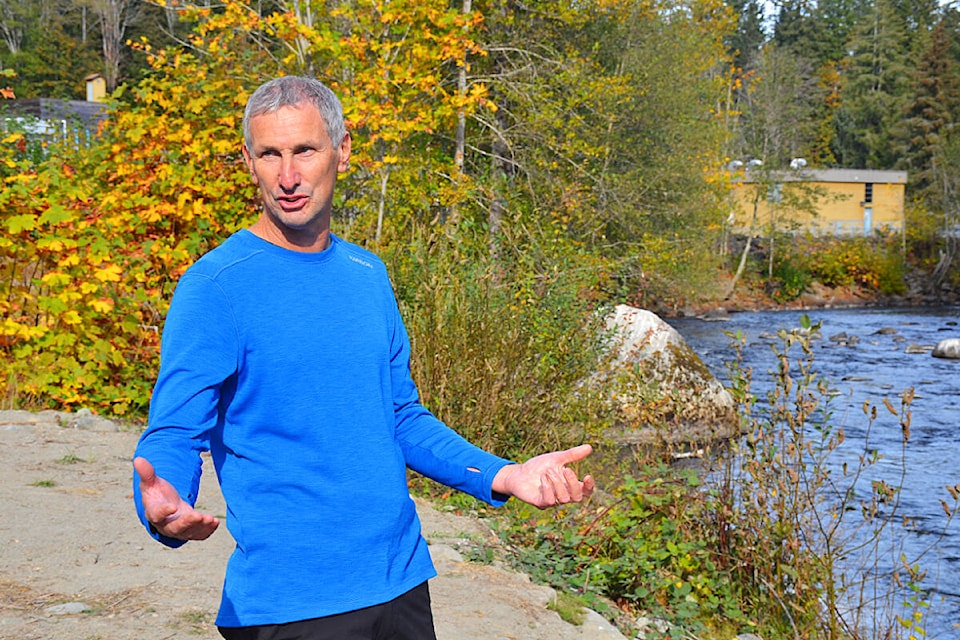Despite some rain in the forecast, BC Hydro is mobilizing to mitigate drought conditions and save fish habitat on the Quinsam River system west of Campbell River.
Four pumps are being installed on the shore of Upper Quinsam Lake in order to pump water into adjacent Wokas Lake because the two lakes are in danger of losing their connection due to lowering water levels.
With the extended hot and dry weather, water storage on the Quinsam River system has diminished to critical levels and may separate around Oct. 23, BC Hydro spokesperson Stephen Watson says.
“Given the importance of fish and fish habitat within the Quinsam River, Indigenous and community interests in fish, and our environmental objectives, we are going beyond our water licence requirements to try to maintain the current river flow rate,” Watson says. “We mobilized crews this week to pump water from Upper Quinsam Lake into Wokas Lake to ensure we can continue to provide water flows down the Quinsam River to protect fish habitat. This is a step we have only taken once before in October 2000.
“We are taking this action because our current modelling and the weather forecast indicates we will be unable to access water stored in the Upper Quinsam Lake by around Sunday (Oct. 23), and flows would otherwise begin to decline. Further, by around Nov. 8, the Wokas Lake may reach a level where we may be unable to discharge any water flow downstream.”
There are two dams on the Quinsam River system, a tributary of the Campbell River. The Upper Quinsam Storage Dam is near the Wokas Lake outlet, and then further downstream is the Quinsam River Diversion Dam. BC Hydro can divert extra water from the Quinsam River into the Lower Campbell River/McIvor Lake for power generation and other water use benefits. However, seeing the shift in weather, and the lakes being in good shape, the utility stopped diverting water on Aug. 11.
“We provided the minimum fish habitat flow of one cubic metre per second (m3/s) into the early fall but seeing the ongoing extreme drought conditions, and the low lake storage, on Oct. 7 we reduced the Quinsam River flow to a 0.7 m3/s target rate,” Watson says. “At this time, there is no water coming into the Upper Quinsam Lake though there is some precipitation in the forecast.”
BC Hydro is mobilizing a series of pumps this week that will be pumping water from Upper Quinsam Lake through several hundred metres of piping to Wokas Lake. The pumps will then provide the current flow rate of about 0.7 m3/s into Wokas Lake. The plan is to have them operational and pumping by Friday, Oct. 21.
BC Hydro worked out an agreement with Mosaic Forest Management to allow it to gain access to two key areas to do the work. Campsites near the area have been closed for the season.
“It is estimated that our temporary water pumping works will be able to provide the flow rate into the Quinsam River to the end of November, though we expect the situation to improve before that time because we know, historically, the rain starts by the end of October,” Watson says.
These responses to the drought conditions have been made through ongoing discussions with Fisheries and Oceans Canada (DFO). Coho, Chinook and large numbers of pink salmon could be impacted if flow was not maintained due to drought conditions. The DFO target of 250,000 pink salmon reaching upstream of their Quinsam River Hatchery fence has been achieved as of mid-October. There are currently about 325,000 pink in the 28 km anadromous section on the river. Pink spawning should be complete by now.
Coho in the Quinsam River would also be impacted by drought conditions. There are about 600 coho adults in the Quinsam River that will start spawning after Oct 31, Watson says. They are likely to be sitting in pools when not actively moving. There are also coho and steelhead juveniles in the system. The pumping will ensure they have the same flow they normally have from Nov. 1 onwards.
The Chinook are currently downstream of the Quinsam River Hatchery fence, as well as still in the Campbell River and have started spawning. The recent flow reduction will make it more difficult for chinook to access the Quinsam River as well as for the hatchery to collect their chinook broodstock.
The Quinsam River watershed also provides habitat for other resident fish species including rainbow trout, cutthroat trout, Dolly Varden, lamprey and sculpin throughout the lake and river sections of the watershed.
There may be a shift in the weather with some rain but a series of storms would be needed to improve the situation. The pumps at Upper Quinsam Lake will be removed once the natural inflows are near normal again and the lake elevations have increased.
Quinsam River Hatchery manager Ed Walls said the contrast between this year and last year is vast with torrential rains this time last year.
“We’ve seen a summer that’s unprecedented dry,” Walls said. “Fish habitat is shrinking.”
Hes thankful for BC Hdyro’s plan to increase flows in the Quinsam River.
“If BC Hydro didn’t do what they’re doing there would pretty much be no flow, none left in the Quinsam.”
@AlstrT
editor@campbellrivermirror.com
Like us on Facebook and follow us on Twitter



